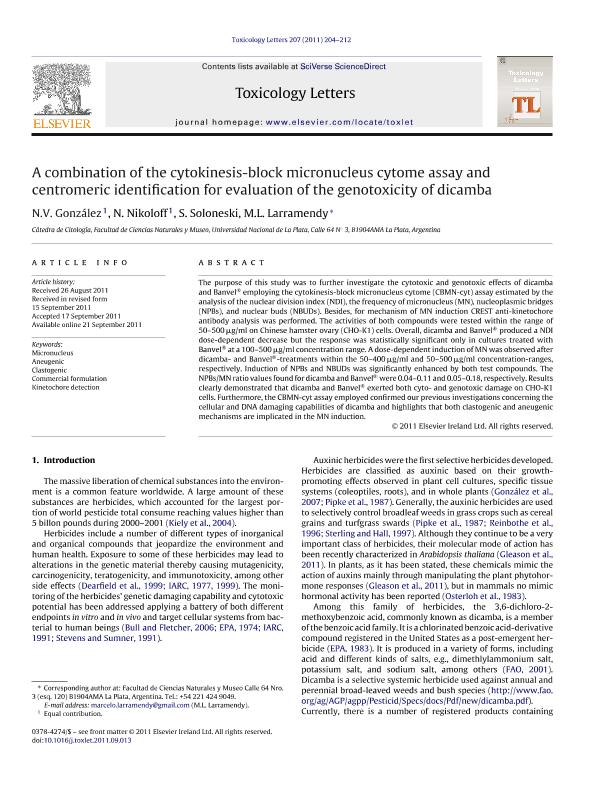Mostrar el registro sencillo del ítem
dc.contributor.author
González, N.V.
dc.contributor.author
Nikoloff, Noelia

dc.contributor.author
Soloneski, Sonia Maria Elsa

dc.contributor.author
Larramendy, Marcelo Luis

dc.date.available
2020-01-23T18:01:19Z
dc.date.issued
2011-12
dc.identifier.citation
González, N.V.; Nikoloff, Noelia; Soloneski, Sonia Maria Elsa; Larramendy, Marcelo Luis; A combination of the cytokinesis-block micronucleus cytome assay and centromeric identification for evaluation of the genotoxicity of dicamba; Elsevier Ireland; Toxicology Letters; 207; 3; 12-2011; 204-212
dc.identifier.issn
0378-4274
dc.identifier.uri
http://hdl.handle.net/11336/95667
dc.description.abstract
The purpose of this study was to further investigate the cytotoxic and genotoxic effects of dicamba and Banvel® employing the cytokinesis-block micronucleus cytome (CBMN-cyt) assay estimated by the analysis of the nuclear division index (NDI), the frequency of micronucleus (MN), nucleoplasmic bridges (NPBs), and nuclear buds (NBUDs). Besides, for mechanism of MN induction CREST anti-kinetochore antibody analysis was performed. The activities of both compounds were tested within the range of 50–500 μg/ml on Chinese hamster ovary (CHO-K1) cells. Overall, dicamba and Banvel® produced a NDI dose-dependent decrease but the response was statistically significant only in cultures treated with Banvel® at a 100–500 μg/ml concentration range. A dose-dependent induction of MN was observed after dicamba- and Banvel®-treatments within the 50–400 μg/ml and 50–500 μg/ml concentration-ranges, respectively. Induction of NPBs and NBUDs was significantly enhanced by both test compounds. The NPBs/MN ratio values found for dicamba and Banvel® were 0.04–0.11 and 0.05–0.18, respectively. Results clearly demonstrated that dicamba and Banvel® exerted both cyto- and genotoxic damage on CHO-K1 cells. Furthermore, the CBMN-cyt assay employed confirmed our previous investigations concerning the cellular and DNA damaging capabilities of dicamba and highlights that both clastogenic and aneugenic mechanisms are implicated in the MN induction.
dc.format
application/pdf
dc.language.iso
eng
dc.publisher
Elsevier Ireland

dc.rights
info:eu-repo/semantics/openAccess
dc.rights.uri
https://creativecommons.org/licenses/by-nc-sa/2.5/ar/
dc.subject
GENOTOXICITY
dc.subject
CYTOTOXICITY
dc.subject
DICAMBA
dc.subject
BANVEL
dc.subject.classification
Biología Celular, Microbiología

dc.subject.classification
Ciencias Biológicas

dc.subject.classification
CIENCIAS NATURALES Y EXACTAS

dc.title
A combination of the cytokinesis-block micronucleus cytome assay and centromeric identification for evaluation of the genotoxicity of dicamba
dc.type
info:eu-repo/semantics/article
dc.type
info:ar-repo/semantics/artículo
dc.type
info:eu-repo/semantics/publishedVersion
dc.date.updated
2020-01-22T19:57:57Z
dc.journal.volume
207
dc.journal.number
3
dc.journal.pagination
204-212
dc.journal.pais
Irlanda

dc.description.fil
Fil: González, N.V.. Universidad Nacional de La Plata. Facultad de Ciencias Naturales y Museo. Cátedra de Citología; Argentina
dc.description.fil
Fil: Nikoloff, Noelia. Consejo Nacional de Investigaciones Científicas y Técnicas; Argentina. Universidad Nacional de La Plata. Facultad de Ciencias Naturales y Museo. Cátedra de Citología; Argentina
dc.description.fil
Fil: Soloneski, Sonia Maria Elsa. Consejo Nacional de Investigaciones Científicas y Técnicas; Argentina. Universidad Nacional de La Plata. Facultad de Ciencias Naturales y Museo. Cátedra de Citología; Argentina
dc.description.fil
Fil: Larramendy, Marcelo Luis. Universidad Nacional de La Plata. Facultad de Ciencias Naturales y Museo. Cátedra de Citología; Argentina. Consejo Nacional de Investigaciones Científicas y Técnicas; Argentina
dc.journal.title
Toxicology Letters

dc.relation.alternativeid
info:eu-repo/semantics/altIdentifier/url/https://www.sciencedirect.com/science/article/pii/S0378427411015323
dc.relation.alternativeid
info:eu-repo/semantics/altIdentifier/doi/http://dx.doi.org/10.1016/j.toxlet.2011.09.013
Archivos asociados
